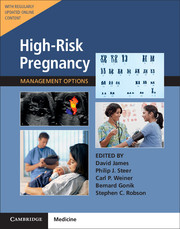Book contents
- Frontmatter
- Contents
- List of Contributors
- Preface
- Section 1 Prepregnancy Problems
- 1 Constitutional and Environmental Factors Leading to a High-Risk Pregnancy
- 2 Domestic Violence in Pregnancy
- 3 Female Genital Mutilation and Pregnancy
- 4 Genetics, Risks of Recurrence, and Genetic Counseling
- Section 2 Early Prenatal Problems
- Section 3 Late Prenatal – Fetal Problems
- Section 4 Problems Associated with Infection
- Section 5 Late Pregnancy – Maternal Problems
- Section 6 Late Prenatal – Obstetric Problems
- Section 7 Postnatal Problems
- Section 8 Normal Values
- Index
1 - Constitutional and Environmental Factors Leading to a High-Risk Pregnancy
from Section 1 - Prepregnancy Problems
- Frontmatter
- Contents
- List of Contributors
- Preface
- Section 1 Prepregnancy Problems
- 1 Constitutional and Environmental Factors Leading to a High-Risk Pregnancy
- 2 Domestic Violence in Pregnancy
- 3 Female Genital Mutilation and Pregnancy
- 4 Genetics, Risks of Recurrence, and Genetic Counseling
- Section 2 Early Prenatal Problems
- Section 3 Late Prenatal – Fetal Problems
- Section 4 Problems Associated with Infection
- Section 5 Late Pregnancy – Maternal Problems
- Section 6 Late Prenatal – Obstetric Problems
- Section 7 Postnatal Problems
- Section 8 Normal Values
- Index
Summary
Definition of a High-Risk Pregnancy
Each pregnancy is a unique, physiologically normal episode in a woman's life. However, preexisting disease or unexpected illness of the mother and/or the fetus may complicate the pregnancy.
Risk is defined as the probability that an adverse condition or event will occur within a stated period of time by exposure to specified health hazards (e.g., smoking) or by the presence of one or more ascertainable characteristics (risk factors, or indicators) (e.g., ethnicity, advanced maternal age).
A pregnancy is defined as high risk when the probability of an adverse outcome for the mother or child among the “exposed” population is increased over and above the baseline risk of that outcome among the reference (“unexposed” or general) pregnant population. This classification does not take into consideration the magnitude of risk or the importance of the risk to the health outcome of the pregnant population at large (attributable risk).
Mathematical Concepts of Risk
In scientific research risks are commonly expressed as:
• Relative risk (RR), which is synonymous with risk ratio, i.e., the ratio of the risk of adverse outcome among the “exposed” population to the risk among the “unexposed” population,
or:
• Odds ratio (OR), which is synonymous with the relative odds, i.e., the ratio of two odds in a population. The OR approximates to the RR if the disease is relatively rare.
If the RR (or OR) is greater than 1 and the 95% confidence interval (CI) does not cross 1, then “exposure” is typically considered to be statistically significantly associated with adverse outcome.
RR (and OR) values indicate the actual probability of an adverse event occurring among the “exposed” population. This actual risk is often referred to as absolute risk. It can be calculated from the frequency of occurrence of the adverse condition among the reference population (prevalence, expressed as probability or odds) multiplied by the given value of the RR (or OR).
A third way to quantify associations is the absolute risk reduction (ARR), which is the difference between the probability of an adverse outcome in the “exposed” population and in the “unexposed” population.
- Type
- Chapter
- Information
- High-Risk Pregnancy: Management OptionsFive-Year Institutional Subscription with Online Updates, pp. 1 - 34Publisher: Cambridge University PressFirst published in: 2017
- 1
- Cited by



